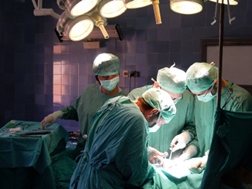LAWSUITS NEWS & LEGAL INFORMATION
Operating Room Equipment Injury
Were you looking for 3M Bair Hugger Infections or daVinci Robot or Duodenoscope Infection Risk or Hospital Burns or FDA Warns Against Laparoscopic Power Morcellation or Sorin Stockert 3T Heater-Cooler System Infection or Stryker Triathlon Knee Implant Injury lawsuits?
By Jane Mundy
A number of surgical procedures involving operating room equipment result in operating room injury. Although most surgeries are successful, some can go wrong and they are often not the result of the surgical team. Most common are burn injuries from OR fire, which can be caused by defective medical equipment. If you were injured during surgery and believe it was caused by a defective medical device, you should speak to an operating room injury lawyer.
FREE OPERATING ROOM EQUIPMENT LAWSUIT EVALUATION
Send your Operating Room Equipment claim to a lawyer who will review your claim at NO COST or obligation.
GET LEGAL HELP NOW
GET LEGAL HELP NOW
Operating Room Injuries
Operating Room Fire Injuries
Causes of Hospital Fires include three factors:
- An oxidizer (anesthesia products such as oxygen and nitrous oxide)
Electrosurgical tools called "Bovies" start about 70 percent of all surgical fires. These tools use a high-frequency electric current to cut tissue or stop bleeding. About 20 percent of hospital fires are sparked by burrs, defibrillators, hot wires or light sources, while approximately 10 percent are ignited by lasers. DaVinci Surgical Robot Injury The daVinci surgical robot, used in many surgeries across the US, was designed to make surgery less invasive. But DaVinci robot lawsuits against Intuitive Surgical, the manufacturer, claim that flaws in the design have caused serious complications, permanent injuries and death. Most reports involve burns to internal organs and intestines, some of which were not apparent until after surgery. In February 2013, the Da Vinci system was involved in 70 patient deaths, according to Bloomberg News.
After Intuitive admitted that not all components were tested according to standards of compliance, the FDA in 2013 conducted a Class II recall of 30 components used in the technology.
A New York father claimed his daughter, who underwent a hysterectomy at a Bronx hospital, died as a result of the da Vinci surgical robot defective design. The hospital burn lawsuit claims the woman' artery and intestines were burnt due to design flaws that include un-insulated surgical arms and use of electrical current which can jump to healthy internal organs and tissue. As well, the lawsuit claims that Intuitive Surgical failed to conduct randomized studies to assess complications that may be associated with use of the da Vinci Surgical Robot.
The FDA issued a safety communication warning against the use of laparoscopic power morcellation for hysterectomy or myomectomy (uterine fibroid removal). Of concern are reports of the spread of unsuspected cancerous tissue—specifically, uterine sarcoma—during laparoscopic hysterectomy. Laparoscopic power morcellation lawsuits have now been filed by women alleging they were harmed by the use of a power morcellator during laparoscopic hysterectomy.
The Stryker ShapeMatch Cutting Guide was designed as a disposable guide to help surgeons mark and cut bones before a knee replacement operation with Stryker' Triathlon Knee System. There have been numerous reports of injury due to a defect that allowed "wider cutting ranges", believed to be responsible for prosthetics that don't fit properly or result in premature failure. The FDA in 2013 issued a Class 1 recall of the Stryker CuttingMatch Guides. A number of defective product claims against Stryker have been filed.
The 3M Bair Hugger Warming System is a Forced-Air Warming blanket medical device designed to keep patients warm during orthopedic surgery and reduce the risk of infections. But Bair Hugger lawsuits allege warming blanket injury and warming blanket infection. A number of 3M Bair Hugger injury lawsuits have been filed by patients who had hip or knee replacements and developed Deep Joint Infections. One patient who filed a Bair Hugger defective medical device lawsuit needed his leg amputated after developing infection following surgery.
Surgical Lights Injury
Endoscopic Procedures Injury
Trocar Injuries
Operating Room Equipment Injury Legal Help
Victims in operating room injuries involving the above OR equipment should consult with an experienced operating room injury lawyer. If you or a loved one has suffered similar damages or injuries, please click the link below and your complaint will be sent to a personal injury lawyer who may evaluate your claim at no cost or obligation.Last updated on
OPERATING ROOM EQUIPMENT LAWSUITS
- Sorin Stockert 3T Heater-Cooler System Infection Lawsuit alleging increased risk of infection during certain surgeries
- 3M Bair Hugger Injury lawsuits filed by patients who had hip or knee replacements and developed Deep Joint Infections.
- Duodenoscope Infection Risk linked to the spread of deadly bacteria
- Laparoscopic Power Morcellation FDA Warning
- Stryker Triathlon Knee Implant Injury using Shapematch Cutting Guide
- daVinci Surgical Robot Complaints
- Hospital Burns alleged malpractice leading to burn injuries.
OPERATING ROOM EQUIPMENT LEGAL ARTICLES AND INTERVIEWS
Filing a Bair Hugger Lawsuit: Attorney Weighs In

Last-Ditch Effort for 3M Bair Hugger Appeal

Two Open-Heart Surgery Outcomes Involving Stockert 3T Heater-Cooler System


January 3, 2023
Gabriel Assaad has filed lawsuits against 3M and Arizant Healthcare (3M acquired Arizant in 2010) on behalf of patients who developed periprosthetic joint infections (PJI) after undergoing joint replacement surgery where a Bair Hugger warming blanket was used. If you had a knee or hip replacement surgery, suffered an infection and required additional surgery on your implant, you may be entitled to compensation. READ MORE
Last-Ditch Effort for 3M Bair Hugger Appeal

October 4, 2022
3M has asked the U.S. Supreme Court to grant a review of the U.S. appeals court decision to reinstate close to 6,000 Bair Hugger lawsuits claiming the warming blanket used in surgery results in knee and hip infections. In August 2021, the US Court of Appeals for the Eighth Circuit revived the lawsuits. READ MORE
Two Open-Heart Surgery Outcomes Involving Stockert 3T Heater-Cooler System

April 29, 2022
The chances of developing an infection after cardiac surgery is slim – an estimated 1 in 5,000 patients who had heart valve surgery and even lower for other types of surgery. But that percentage is higher if a Stockert 3T Heater-Cooler was used during surgery. Rod says he hasn’t recovered from his heart surgery and Carol’s husband died from infection. Now they are pursuing a claim against Sorin, the heater-cooler device manufacturer. READ MORE
MORE OPERATING ROOM EQUIPMENT LEGAL NEWS
- Canadian Class Action Accuses Sorin Heater-Cooler System Makers of Failure to Warn
- Stockert 3T Heater-Cooler Case Awaits Consolidation Decision
- More Stockert 3T Heater-Cooler Lawsuits after Slow-Developing Infections
- Don't Use Ultrasonic Aspirators to Remove Uterine Fibroids FDA States
READ MORE Defective Products Settlements and Legal News
READ MORE Drugs/Medical Settlements and Legal News
READ MORE Personal Injury Settlements and Legal News
READ MORE Drugs/Medical Settlements and Legal News
READ MORE Personal Injury Settlements and Legal News
